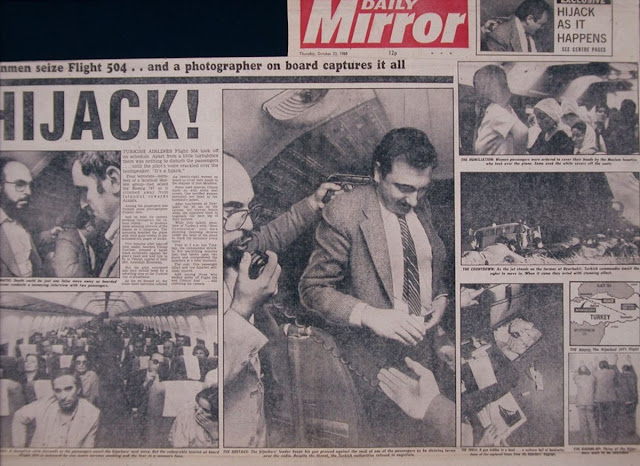On October 14, 1980, Turkish Airlines Boeing 727 type aircraft Diyarbakır was hijacked on the flight from Munich, West Germany to Ankara via Istanbul by four radical Islamist militants. One of the passengers happened to be war correspondent Coşkun Aral, who convinced the hijackers to let him into the cockpit — and took the iconic photos himself.
One of the hijackers can be seen grinning as he points a gun at the pilot’s neck, while the pilot himself smiles calmly, creating a moment both surreal and unsettling.
“It was the 17:35 flight and the aircraft’s name was Diyarbakır,” Aral said. “It takes 40 minutes to get to Ankara but after an hour and a half, we still weren’t there. There were no announcements from the flight deck. Then suddenly we hear this voice saying ‘From now on, Islam commands the plane. Women passengers should cover their hair. If you have nothing to cover it with, use the headrest covers. We wish no harm to anyone onboard. We’re fighting against the military fascist regime. We’ll take the plane to Iran and then to Afghanistan to fight with the mujahideen.’”
“I automatically took out my camera and started taking photos blindly,” the photographer added. “A man was walking down the aisle and, crazily, I asked him for an interview. He rejected my offer. But after a while, a bearded hijacker approached me and told me to follow him. I asked how they managed to smuggle the gun on board. He said they thought of carving a hole inside the Holy Quran, but it would have been a sin; so they found an Arabic dictionary without Turkish or Latin letters on the cover, and put the gun inside. I heard laughing from inside the cockpit. When I entered, everyone had a smile on their faces. The pilot had told the hijacker not to point the gun to his neck: he might be tickled and crash the plane.”
When the Turkish armed forces stormed the plane and put an end to this surreal hijacking, Aral was mistakenly arrested and held captive for four days in a Turkish prison. When he got out, the scoop brought him international fame. His photos became one of the strangest, most human snapshots ever taken in a moment of crisis.
From then on, Aral worked in every conflict-ridden area in the world: Lebanon, Rwanda, Iran/Iraq, Northern Ireland, Liberia, Afghanistan, the Philippines, Nicaragua, Syria… His pictures are merciless, hardcore depictions of the insanity and brutality of war and civil conflicts.









.jpg)

0 comments:
Post a Comment